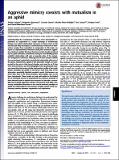Por favor, use este identificador para citar o enlazar a este item:
http://hdl.handle.net/10261/217433COMPARTIR / EXPORTAR:
 SHARE SHARE
 CORE
BASE CORE
BASE
|
|
| Visualizar otros formatos: MARC | Dublin Core | RDF | ORE | MODS | METS | DIDL | DATACITE | |

| Título: | Aggressive mimicry coexists with mutualism in an aphid |
Autor: | Salazar, Adrián; Fürstenau, Benjamin CSIC; Quero, Carmen CSIC ORCID ; Pérez-Hidalgo, N.; Carazo, P.; Font, E.; Martínez-Torres, David | Fecha de publicación: | 2015 | Citación: | Proceedings of the National Academy of Sciences of the United States of America 112: 1101- 1106 (2015) | Resumen: | Understanding the evolutionary transition from interspecific exploitation to cooperation is a major challenge in evolutionary biology. Ant-aphid relationships represent an ideal system to this end because they encompass a coevolutionary continuum of interactions ranging from mutualism to antagonism. In this study, we report an unprecedented interaction along this continuum: aggressive mimicry in aphids.We show that two morphs clonally produced by the aphid Paracletus cimiciformis during its root-dwelling phase establish relationships with ants at opposite sides of the mutualism-antagonism continuum. Although one of these morphs exhibits the conventional trophobiotic (mutualistic) relationship with ants of the genus Tetramorium, aphids of the alternative morph are transported by the ants to their brood chamber and cared for as if they were true ant larvae. Gas chromatography-mass spectrometry analyses reveal that the innate cuticular hydrocarbon profile of the mimic morph resembles the profile of ant larvae more than that of the alternative, genetically identical nonmimic morph. Furthermore, we show that, once in the brood chamber, mimic aphids suck on ant larva hemolymph. These results not only add aphids to the limited list of arthropods known to biosynthesize the cuticular chemicals of their deceived hosts to exploit their resources but describe a remarkable case of plastic aggressive mimicry. The present work adds a previously unidentified dimension to the classical textbook paradigm of aphid-ant relationships by showcasing a complex system at the evolutionary interface between cooperation and exploitation. | Versión del editor: | http://dx.doi.org/10.1073/pnas.1414061112 | URI: | http://hdl.handle.net/10261/217433 | DOI: | 10.1073/pnas.1414061112 | Identificadores: | doi: 10.1073/pnas.1414061112 issn: 1091-6490 |
| Aparece en las colecciones: | (IQAC) Artículos |
Ficheros en este ítem:
| Fichero | Descripción | Tamaño | Formato | |
|---|---|---|---|---|
| 1101.full.pdf | 1,33 MB | Adobe PDF |  Visualizar/Abrir |
CORE Recommender
PubMed Central
Citations
7
checked on 21-abr-2024
SCOPUSTM
Citations
23
checked on 15-abr-2024
WEB OF SCIENCETM
Citations
20
checked on 22-feb-2024
Page view(s)
117
checked on 23-abr-2024
Download(s)
101
checked on 23-abr-2024
Google ScholarTM
Check
Altmetric
Altmetric
Artículos relacionados:
NOTA: Los ítems de Digital.CSIC están protegidos por copyright, con todos los derechos reservados, a menos que se indique lo contrario.
